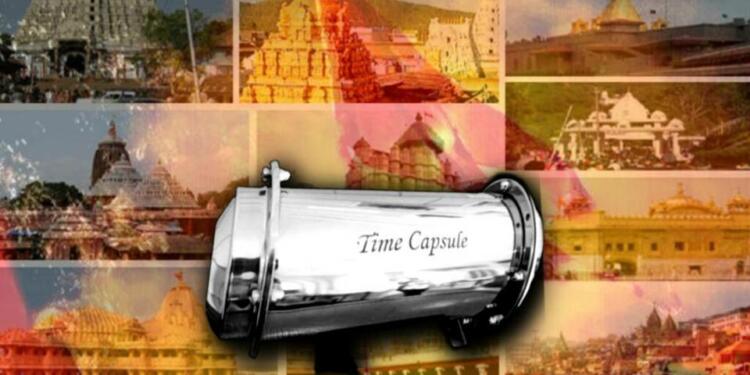Bharat is a continuing civilisation which has suffered multiple assaults that aimed to erase it from the face of earth. Several Mandirs, centres of knowledge and important architecture were demolished to wipe out the history of Bharatvarsha. For example, The Nalanda University was burnt down by the Islamic bigot Bakhtiyar Khilji. Such assaults on cultural, spiritual and educational institutions have deprived us from precious wealth of the past. Unfortunately, we are still witnessing grave threats to our civilisation. So, it becomes imperative to face it with utter sincerity but at the same time, find ways to pass along the correct facts and knowledge about historically, culturally and educationally significant places to the next generations.
What if there had been a Time Capsule?
The Hindu community struggled for more than five centuries to reclaim the birthplace of Maryada Purushottam Shri Ram. The legal battle to prove the birthplace was cumbersome and time consuming especially when the other side was hell bent to hamper development at each step. Additionally, the findings of Hindu symbols and idols of Hindu deities in Gyanvapi-Shringar Gauri Mandir complex has unearthed the truth of this holy shrine as well but the legal dispute is still far away from being over.
The case may be different in other plundered Mandir sites. These destroyed Mandir sites have been under illegal occupation for hundreds of years, so a complete destruction of evidence of Indian civilisational history can’t be ruled out. That is why, the use of Time Capsule becomes much more significant.
As had there been a time capsule buried beneath these Mandir complexes, the facades of ownerships, property dispute etc cropped up by the Islamo-leftist cabal, would have been dusted then and there and the legal battle would be much easier and judicious.
So, what is a time capsule?
Time capsule can be a container of any shape or size, which includes documents, photos and artefacts of contemporary times. Through it, the important developments, knowledge of the present or condensed past can be passed on to next generations. It is buried underground with hope for future generations to unearth it. Special requirements are made so that the intended documents don’t decay when dug out after a certain time period by the next generation. The encasing of the time capsule is generally made from materials like aluminium and stainless steel. The documents are inked on acid-free papers.
The term “time capsule” was coined in the 20th century. But evidence of its usage dates much before that . In December 2017 during the restoration work, historians found a time capsule dated around 1777 inside the statue of Jesus Christ in a church in Spain.
Also Read: The Indian Avengers: Four Bravehearts who kept India safe from Islamic Invasion for 313 years
According to a US based institute, The International Time Capsule Society (ITCS), there are 10,000-15,000 time capsules buried all over the world.
History of Time Capsule in India
The prominent example of time capsules in India dates back to the time of the first female PM of India, Mrs Indira Gandhi. In 1972, to celebrate the 25th year of India’s Independence and commemorate the freedom struggle, a time capsule was buried outside the Red fort complex. The Indira Gandhi government also wanted to manuscript important events in history, along with contemporary achievements. The time capsule was named Kalpaatra. It yearmarked a time frame of 1,000 years for digging out the time capsule.
It assigned the task to the Indian Council of Historical Research (ICHR) of drawing out significant happenings from the past. However, the then government faced heavy backlash from the opposition for over glorification of the Gandhi family. In 1977, the Indira Gandhi government was overthrown by Morarji Desai led Janata Party. In the elections it had promised to dig out the kalpaatra and reevaluate its content. Within days of forming the government, the Janata party unearthed the capsule. Although the government didn’t divulge its content, senior journalists claim that the content was full of praises for Indira Gandhi and her father Jawaharlal Nehru.
Read More: Doordarshan is launching an antidote to Nehru’s ill researched ‘Bharat ek Khoj’
Other time capsules are at a school in Mumbai, IIT-Kanpur, Lovely Professional University in Jalandhar, and Mahatma Mandir in Gandhinagar.
Where can it be used and how will it be helpful in protecting the civilisation of Bharat?
During the foundation laying of the Ram Mandir in Ayodhya, it was claimed that a time capsule will be buried along with the foundational stones. News reports claimed that it will enclose the documents about the struggles for reclaiming the birthplace of Bhagwan Shri Ram and facts about the mandir complex among other major contemporary achievements. Although the reports were denied, it opened a healthy debate for society. It is our duty to pass on the correct knowledge and historical facts to the next generations. So that they don’t have to indulge in such long struggles to reclaim the wealth of India’s civilisation.
The time capsule may be helpful in the major holy shrines of Hinduism like Mata Vaishno Devi Mandir, Kashi Vishwanath temple or the twelve Jyotirlingas. If the future generations are not wiser than the present and have to struggle to strive for the already accumulated knowledge then we have failed as a civilisation. So, It can also be used to pass on the unaltered history and Indic knowledge of Vedas,other scriptures and science of Ayurveda among other endless wealths of Indian civilisation. In this way, time capsules can be an effective tool to protect our civilisational knowledge and history from being further destroyed or altered by the attackers or their sympathisers.
Support TFI:
Support us to strengthen the ‘Right’ ideology of cultural nationalism by purchasing the best quality garments from TFI-STORE.COM


































